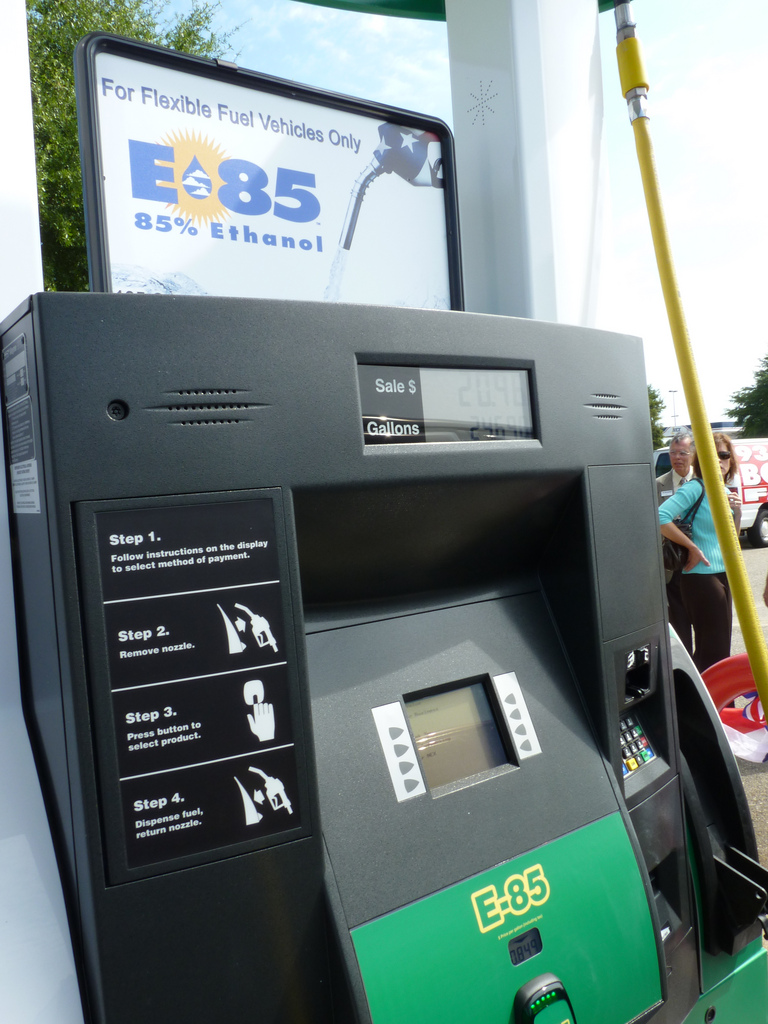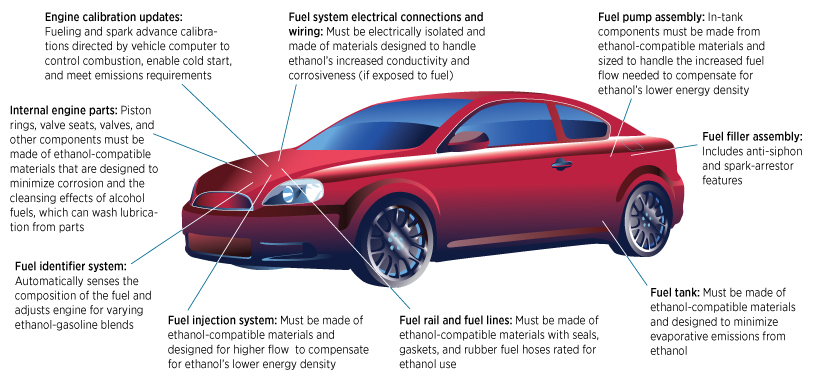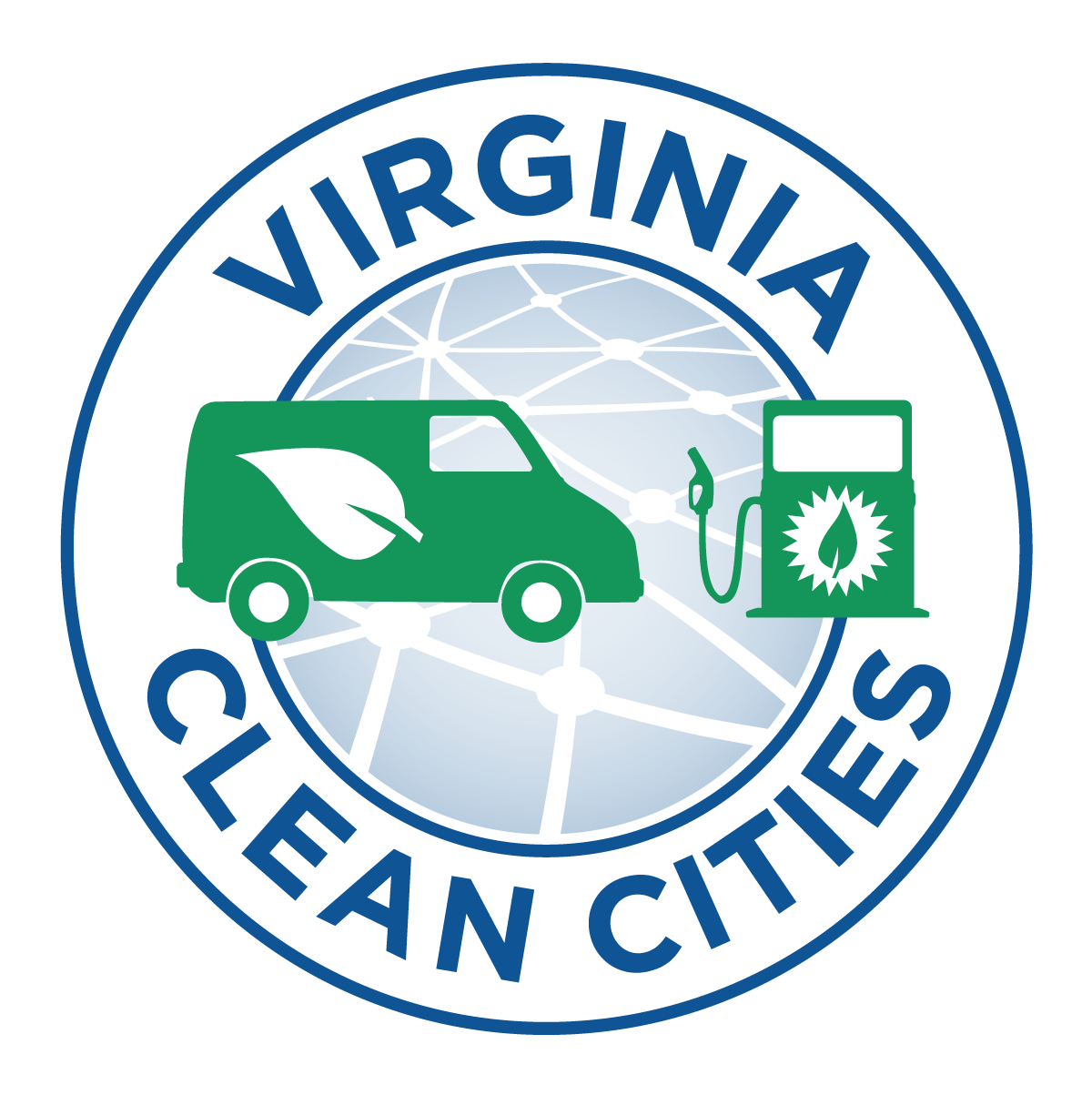 Ethanol Quick Facts
Ethanol Quick Facts
- Ethanol is a renewable fuel made from various plant materials collectively known as “biomass.” More than 95% of U.S. gasoline contains ethanol in a low-level blend to oxygenate the fuel and reduce air pollution.
- It is a colorless liquid distilled from agricultural crops – usually corn.
- Ethanol can be produced not only from corn, barley, and wheat, but also from cellulose feedstocks, such as corn stalks, rice straw, sugar cane bagasse, pulpwood, switchgrass, and municipal solid waste.
- Ethanol Myths and Facts
- RFA Ethanol Facts
- WATCH: 40 Facts About Ethanol
Frequently Asked Ethanol Questions and Answers:
Where can I find Ethanol Stations?
What are the different blends of Ethanol?
What are the Benefits of Using Ethanol?
What vehicles run on ethanol and how do they perform?
Where can I learn more about state and federal laws and incentives?
Ethanol Stations
Use the Alternative Fuels Data Center’s Station Locator to find public ethanol stations in Virginia.
Locations are subject to change, so we recommend calling the stations to verify location, hours of operation, and access.
Ethanol Blends
- E10 – a blend of 10% ethanol and 90% gasoline. More than 70% of American gas stations now sell E10, but as newer vehicles are manufactured, the industry will shift to raise the standard by 5% for more E15 use.
- E15 – a blend of 15% ethanol and 85% gasoline. This is a newer higher octane fuel. The EPA has approved E15 use in vehicles year 2001 and newer.
- E20, E30, E40 (Mid-Level Blends) – Fuels that are blended between 10% and 85% ethanol. All flex- fuel vehicles on the road are manufactured to operate on gasoline and up to 85% ethanol so mid-level blends can be dispensed at stations that have blender pump infrastructure.
- E85 – a blend of 85% ethanol and 15% gasoline. This is the most common and generally the highest ethanol fuel mixture sold by retailers in the United States. E85 is the standard fuel for Flex-Fuel Vehicles (FFVs).
- E100 – pure ethanol fuel.
The Benefits of Using Ethanol
- Using E85 reduces petroleum consumption: use of E85 will reduce overall use of petroleum and replace it with renewable-based fuel produced in the U.S.
- E85 is better for the environment: E85 offers environmental benefits such as reducing carbon monoxide, volatile organic compounds, nitrogen oxides, and particulate matter emissions when compared to gas.
- Flexible Fuel Vehicles (FFVs) are available and affordable: FFVs specifically designed to run on E85 are becoming more common each model year, and FFVs are typically available as standard equipment with little or no incremental cost.
- FFVs have flexible fueling options: FFVs may operate on gasoline or E85, and a driver may simply fuel with either fuel as the situation dictates.
- E85 is easy to use and handle: E85 fueling equipment is only slightly different and of similar cost, and is similar to petroleum fuel storage and dispensing.
What Vehicles Can Use Ethanol and How Does it Perform?
Flexible-Fuel Vehicles (FFVs)
All gasoline vehicles are capable of operating on gasoline and ethanol blends with up to 10% ethanol. In fact, some states require the seasonal or year-round use of up to 10% ethanol as an oxygenate additive to gasoline to mitigate ozone formation. These low percentage oxygenate blends are not classified as alternative fuels.
We speak of ethanol vehicles as those specifically manufactured to be capable of running on up to 85% denatured ethanol, 15% gasoline (E85), or any mixture of the two up to the 85% ethanol limit. E85 may be seasonally adjusted in colder climates such that the real proportion of E85 is less than 85% ethanol. Vehicles manufactured for E85 use are commonly called flexible-fuel vehicles (FFVs). They are available in a variety of makes and models. Use the Alternative Fuels Data Center’s Light-Duty Vehicle Search to browse available models.

Special Components of a Flex Fuel Vehicle
Source: Alternative Fuels Data Center http://www.afdc.energy.gov/vehicles/flexible_fuel.html
Performance
From a consumer perspective, there is no noticeable difference in vehicle performance when E10 is used. Because ethanol has lower energy content than gasoline, E85 use reduces fuel economy. The magnitude of the reduction depends on the vehicle, driving habits and conditions, but 15% is an often-cited average.
Ethanol Production in Virginia
Most ethanol is produced in the grain-growing states of mid-western U.S., but Vireol Ltd is opening an ethanol plant in Hopewell, VA in Spring 2014 that will have a capacity of 62 million gallons of bioethanol a year. The plant will produce ethanol from corn, barley, and other small grains. The company will invest $26.2 million to begin production and will create 70 new jobs. Stay tuned for more information on how the increased production will effect ethanol as a transportation fuel in the Commonwealth!
State and Federal Laws and Incentives for Ethanol
Virginia Laws and Incentives
Incentives
- Biofuels Production Grants (Reference House Bill 1025, 2014, and Virginia Code 45.1-393 and 45.1-394)
- Agriculture and Forestry Biofuel Production Grants (Reference Virginia Code 3.2-304)
- Alternative Fuels Grants and Loans (Reference Virginia Code 33.1-223.4 and 33.1-223.7)
- Alternative Fuel Job Creation Tax Credit (Reference Virginia Code 58.1-439.1)
- Green Jobs Tax Credit (Reference Virginia Code 58.1-439.12:05)
- Alternative Fuel Vehicle (AFV) Fueling Infrastructure Loans (Reference Virginia Code 22.1-146)
- Ethanol Production Equipment Tax Exemption (Reference Virginia Code 58.1-3505)
- Biofuel Feedstock Registration Exemption (Reference Virginia Code 3.2-5508 through 3.2-5516)
- Alternative Fuel Tax Exemption (Reference Virginia Code 58.1-2250)
Laws
- Alternative Fuel Vehicle (AFV) Conversion Fund. For more information, see the Virginia Department of General Services website (Reference House Bill 340, 2014, and Virginia Code 2.2-1176.1)
- Alternative Fuel and Vehicle Tax (Reference Senate Bill 127, 2014, and Virginia Code 58.1-2217 and 58.1-2249)
- Alternative Fuel License For more information, see the DMV Fuels Tax Licensing website under Commercial Services and Fuels Tax. (Reference Virginia Code 58.1-2244)
- State Energy Plan. For more information, see the Virginia Energy Plan website.
For full summaries of all the laws and incentives for Ethanol in the Commonwealth of Virginia, please visit AFDC’s Virginia Laws and Incentives for Ethanol page.
Federal Laws and Regulations
The Renewable Fuel Standard (RFS) Program
The Renewable Fuel Standard (RFS) Program began as a result of the Energy Policy Act of 2005. The Environmental Protection Agency (EPA) finalized the program and it became effective on September 1, 2007. The Program’s goal is to increase the volume of renewable fuel that is blended in transportation fuels and to use 36 billion gallons of renewable fuel each year by 2022. Renewable fuel categories include conventional biofuel, biomass-based diesel, cellulosic biofuel, and other advanced biofuels. Oil refiners, blenders, and gasoline and diesel importers are regulated by RFS. To track compliance and facilitate the program, producers and importers must generate Renewable Identification Numbers (RINs) by selling the required biofuel volumes or must purchase RINs from parties that exceed their requirements.
The Energy Independence and Security Act of 2007 (EISA) set yearly RFS volume requirements for each renewable fuel category. EPA updates volume requirements each year based on fuel availability. Source: Alternative Fuels Data CenterFor a full review of Federal Incentives and Regulations related to Ethanol, please visit AFDC’s Laws and Incentives page.
Technical Information on E85
- Handbook for Handling, Storing, and Dispensing E85
- A checklist for installing or converting equipment for E85.
- How to convert a petroleum (gasoline or diesel) refueling system to E85.
- E85 Fleet Toolkit has information and links to ensure a successful conversion to E85.
Current Clean Cities Ethanol Projects
Mid-Atlantic Biofuel Infrastructure Partnership
VCC has partnered with private sector infrastructure companies and the USDA Biofuel Infrastructure Program to advance ethanol use in the Mid-Atlantic region and to install 53 additional ethanol stations. The Virginia Department of Mines, Minerals and Energy (DMME) will administer the program with the assistance of Virginia Clean Cities (VCC). Partners in the program include two U.S. Department of Energy (DOE) designated Clean Cities Coalitions with assistance from a third that covers the two states and the District of Columbia, as well as agricultural and energy offices of each state. State grain associations and agricultural partners are engaged as well as the private sector infrastructure partners to complete station build.
Past Clean Cities Ethanol Projects
VA-MD-DC E85 Infrastructure Project
Virginia Clean Cities and Virginia’s Department of Mines, Minerals and Energy worked with partners to increase public E85 infrastructure in Virginia, Maryland and the District of Columbia through the Department of Energy’s award for alternative fuel infrastructure. Other partners included Maryland’s Energy Administration and the Virginia Regional Environmental Management System. The list of public and restricted access E85 stations in the VA-MD-DC region that was developed as a result of the project can be found here.
